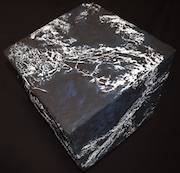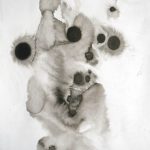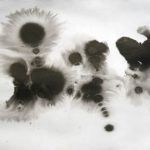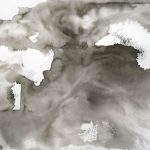| A Return To Darker Waters [2018-01-18] With Roger Batty You can find the original interview on the Musique Machine website at this link. |
To anyone who is even vaguely familiar with the ambient genre, Robert Rich will need little or no introduction. Since the early 80’s this California artists & composer has created a respected & influential body of work- his early work often had more of a darker & brooding tilt, though as his career progressed his work embodied lighter, ethnic, and world music elements. Over the last few years he’s once again returned to the dark side of things- so I caught-up with Robert late last year to discuss this return to darker ambient waters.
M[m]: With both of your recently releases- 2016 Vestiges & last years Lift A Feather To The Flood- you’ve taken a decidedly pared back, darker, and more reflective leaning to your work. Did this just happen organically, or did you mindfully decide to alter your focus?
RR: It’s true, the last few albums are rather brooding. You could include 2016’s “What We Left Behind” with the last two, as a sort of trilogy. The influences blend a dark foreboding about the current direction of humanity, our treatment of each other and the planet, with some meditations on the role that artists can play to help create meaning in the face of adversity. The brooding atmosphere offers a sort of catharsis. I imagined “What We Left Behind” to be a celebration of earth’s resilience in the face of huge extinction events, of which the anthropocene era represents the sixth. I imagined a journey on the wings of a shamanic bird, showing me the earth in a million years, long after we went extinct, with the realization that the other organisms on this planet are better off without us. With that celebration of resilience comes the lingering anger and sadness of our devastation. I needed to put those darker elements away for a while woking on WWLB, because I needed to deal with them separately. Those elements became the seed for “Vestiges” – which also then became a story about my own parents and their decline with age. There’s a poem on the inside of Vestiges, about a ship drifting on slack tide. It’s a metaphor for Alzheimer’s. If we think of my album with Markus Reuter as the third part of this trilogy, the title “Lift a Feather to the Flood” takes on a meaning of the uselessness of art, the role that we play as artists in a world that cannot be fixed. I was discussing these thoughts with Markus before we started the collaboration, and proposed that title in reference to Cervantes’ Don Quixote, who’s Romantic idealism makes him a clown in the eyes of the jaded people around him; yet there is a sort of nobility in his insane clinging to old notions of chivalry. He actually leaves behind a positive effect despite his failings. In our title, the feather could be the act of making art, and the flood could be the torrent of information that drowns us in this very noisy era.
M[m]: The last two albums have seen you utilizing more acoustic piano elements- what attached you to this element, and do you think you could ever see your self-releasing a total piano-based album?
RR: I guess you aren’t familiar with my piano solo album “Open Window” from 2004? I have played piano since I was ten years old, and the baby grand in my studio finds its way onto many albums, but sometimes as a prepared piano, sounding more like gamelan (for example on “Temple of the Invisible” and “Outpost” with Ian Boddy, among others.) In the recent excursions, the piano has a melancholic quality, yet nostalgic and sweet. There’s a trick I also used on “Nest” where I take my piano performance and slow it down to half speed. Everything is originally played twice as fast and an octave higher. At half-speed, the sustain envelope becomes elongated, and the upper harmonics change their effect. I think Brian Eno used a similar technique with Harold Budd on “The Pearl.”
M[m]: No I wasn’t aware of Open Window- I’ll have to check this out. Do you see your piano playing been purely influenced by the ambient sides of things?, or are you influenced by classical piano music?
RR: Probably more influenced by modal jazz, such as McCoy Tyner or Keith Jarrett, and modern tonal classical such as Terry Riley, or the pieces that De Hartmann wrote for Gurdjieff in the early part of the 20th century. I started playing piano when I was a kid, just improvising. It became a rather personal language.
M[m]: As an album Vestiges was very detailed in its sonic landscapes- bringing together the expected synth/ electronic elements, with acoustic elements piano, Lap Steel, Ocarina, and flute. With additions of field recordings & subtle voice elements. There seems a real feeling of carefully planned composition & purpose to every element on the album. How long where you working on it for?
RR: Perhaps it will surprise you that it came together very quickly – maybe a few months. I think about things for a long time though, so the structure had been taking shape in my head during the previous year, while I was working on WWLB.
M[m]: Lift A Feather To The Flood is your first collaboration with German touch guitar master Markus Reuter since 2007’s Eleven Questions. How/when did the idea of this new collaboration come about?
RR: Markus expressed his interest in doing something very quickly, improvised. We have remained good friends for over a decade, and I mixed and mastered several of his albums (Todmorden 513 and two by Centrozoon.) He was on tour with Stick Men (with Tony Levin and Pat Mastelotto) and they had a few days off in January. The only way we could make an album in a few days would be to limit our instruments to the minimum. We decided I would play piano and he would play his laptop with guitar and effects. We discussed our strategy over dinner when he arrived, we recorded for 8 hours straight the next day, which left us with around 2 hours of music. On the last day, we edited the rough tracks to an approximate length, then I dropped him off for a lunch with Tony Levin on his way back to the tour. It took another month for me to finish editing and mixing our performances, but the whole thing essentially comes from one intense day of concentration.
M[m]: Talking of collaborations you’ve done a few over the years. Please discuss some of your favourite collaborations?
RR: Each one of them has special meaning, and is unique to the people involved and the period in time. A great collaboration becomes like a third person. Of course, the two with Steve Roach (Strata and Soma) proved to have some lasting value, and they cemented a lifelong friendship between us. They happened at a perfect phase in our lives when we could offer something special to each other’s vocabulary, and the process of making them was smooth and pleasant. As a matter of fact I think every one of the collaborations has been a treat. You might think that working with Lustmord would be a dip into the dark end of things, but Brian Williams is very positive, friendly and a rather funny crafty Welshman. When Stefano Musso (Alio Die) spent a month with me to work on Fissures, I was living in a small house in a village on the coast near Big Sur. We spent our breaks collecting boletes in the woods, fishing with a friend at low tide under the rocks, hiking in the hills. Stefano and I both share this deep love for the natural world, both of our musical styles are steeped in it, and we found a perfect language together on that album. That album has a healing energy, which I needed at that time.
The three collaborations with Ian Boddy have somewhat colored histories. Ian and I are also longtime friends, and we laugh about the bizarre circumstances that surrounded our first two albums together. We planned for several months to get together in person for “Outpost” back in 2001. Ian purchased airline tickets for an October trip from the U.K. to California, then 9/11 happened. We had no idea if anyone would be flying again in the U.S. anytime soon. We decided to proceed with the plans, and we worked on the album here during a very tense and strange time of paranoia. I live near a Navy air base, and we even included some AM radio security broadcasts from the base transmitter. It suited the album’s theme of a lonely “lighthouse keeper” stranded on a vacant planet at the trailing edge of a fallen empire. (Our visit together a month later, on an icy windswept November day at Hadrian’s Wall, near Ian’s home in Durham, also echoed that story nicely, as we imagined the Roman empire retreating over this soggy landscape.) Skip ahead to 2005, and we planned another collaboration, which became “Lithosphere.” We had started the work remotely, sharing files by mail. Then I had a major accident that sent me to the hospital. I slipped while carrying a large glass container and it sliced through much of my right wrist. Ian arrived only a few weeks after I got out of the second surgery, and my right wrist was immobilized in braces. I recorded most of my parts left handed on that album. Ian ended up doing much of the heavy lifting on that one. Luckily, no disasters happened during the live album “React” we did later in ’08. Thank goodness!
M[m]: How do you feel the way you compose/ arrange music has changed over the years?. And are there pieces of kit you’ve had from the start & still use today?
RR: I still use many of the main elements that I used from the start – homemade flutes, lap steel guitar, modular synth, percussion and various keyboards. I have had a long friendship with some of the original people at Sequential Circuits, and I used a Prophet 5 heavily my early albums. Now with Dave Smith Instruments pulling together some of these same friends, I do a bit of work for them occasionally and use their newer synths, which share some sonic character of the old Prophets, but with much more flexibility. Also, there’s almost a 20-year friendship with Paul Schreiber of Synthesis Technology. I began using his MOTM modular in the late 90s, and also I help him with development. These long relationships with instrument designers leads to a helpful continuity. To be honest, the human connections are more important to me than the gear. I find that ideas dry up when I focus too much on tools and collecting instruments.
M[m]: What have been some of your recent sonic discoveries?
RR: I have been making increasing use of the Haken Continuum, which is a highly developed expressive controller that also contains a powerful internal digital synth I can adapt many of the same pitch inflections I use with lap steel guitar, and add the ease and comfort of a keyboard-style layout. It’s helping me stretch my melodic language a bit.
M[m]: I’ve heard you mention working on a new album- can you tell us a little bit more about this & what can people expect?
RR: This one is rather electronic and more rhythmic than many of the other recent things I did. Lots of modular synthesizers, and making much use of the Haken Continuum .It started out very organic and glitchy, maybe like a sequel to “Bestiary” from 2000. As the album is slowly evolving, it is getting more melodic, with some interesting bends in the modal palate. The theme is the idea that skin is a porous membrane, and our ideas of individual organisms should become more fluid. We are all, in fact, a collection of thousands of different organisms, microbes, fungi, organelles. Likewise, we could see an ant nest or a forest as a single mind, rather than an assortment of different species. I am still experimenting a bit with language to better convey these ideas
M[m]: Do you take much notice of the modern ambient scene?. And if so are there any releases or artists you’ve recently enjoyed?
RR: As a mastering engineer, I get the pleasure of putting my ear to quite a range of music that I work on, so I do feel rather entwined with several threads of the ambient and electronic scene. However, I tend not to think in terms of categories. I just listen to all music as personal expression, some more dynamic, some more static. I think when people get stuck in ideas like “I play blues, or jazz, or IDM, or ambient… etc.” they shut themselves off from expressive languages that would let them do something much more personal and surprising. I love it when people find the unique voice that reflects their own personal experience






You must be logged in to post a comment.